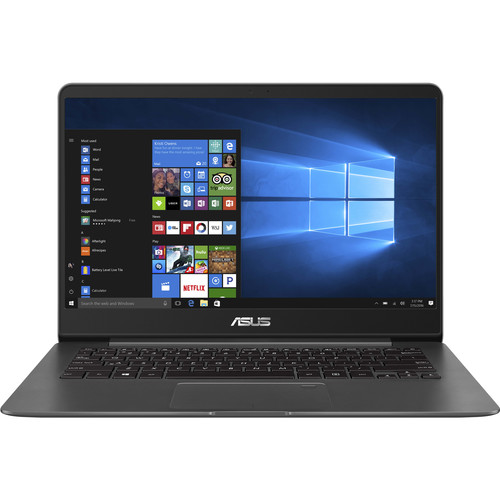Description
ASUS ZenBook 3 Overview
The 14″ ZenBook 3 UX430UA Notebook from ASUS is a thin, lightweight, and compact system designed for users seeking a balance between portability and screen size. It features a 14″ 1920 x 1080 Full HD display, driven by integrated Intel UHD graphics, within a 13″ chassis thanks to its ultra-slim bezels. Performance-wise, it’s powered by a 1.8 GHz Intel Core i7-8550U quad-core processor, 16GB of LPDDR3 RAM, and a 512GB solid-state drive. For more space, attach external storage solutions using its multiple USB ports as well as its media card reader.
Connect to the Internet via 802.11ac Wi-Fi, and pair compatible wireless peripherals using Bluetooth 4.1 technology to free up USB ports for more important devices. Other integrated features include a micro HDMI port, an HD webcam, a fingerprint reader, a backlit keyboard, microphones, speakers, and a 3.5mm mic/headphone jack. The operating system installed is Windows 10 Home (64-Bit).
13″ Chassis & NanoEdge Display
The ZenBook 3 UX430 features a 14″ display in a compact 13″ chassis with minimal bezels. It also has an ultra-wide 100% sRGB color gamut for accurate and vivid colors, as well as 178° viewing angles for easier screen sharing. Moreover, it measures only 0.62″ thick and weighs in at just 2.9 pounds, so you can easily take it wherever life goes.
Fingerprint Sensor
Using the built-in fingerprint sensor in the touchpad and Windows Hello, you’ll be able to log into your system without a password.
Keyboard & Touchpad
The ZenBook 3 UX430 is equipped with a notebook-sized keyboard and built-in backlighting so you’ll be able to type even in dimly lit environments. It has a 1.4mm key travel distance optimized for a comfortable feel, and a touchpad with palm rejection technology and multi-finger gesture and handwriting support.
SonicMaster Audio
Created by the Asus Golden Ear team and Harman Kardon, ASUS SonicMaster audio technology delivers loud and accurate sounds without distortion for a more enjoyable listening experience.
Windows 10 Home
Start Menu
After its hiatus in Windows 8, the Start Menu has returned. Utilizing a combination of the traditional menu system and Windows 8’s Live Tiles, the improved Start Menu gives you more information at a glance, showing notification information alongside your applications and other pinned items.
Cortana
Microsoft’s digital personal assistant, Cortana can answer your questions with information gleaned from both your device and the internet at large. You can type or even talk with her, if your system has a microphone. Using her Notebook, Cortana keeps track of your needs and wants, and she learns over time to improve her information gathering skills.
Microsoft Edge
After nearly 20 years, Microsoft has finally replaced its Internet Explorer web browser. With Microsoft Edge, users can write directly on web pages and share notes with friends and colleagues. It also improves the online reading experience by adding a distraction-free mode and read-it-later functionality. Edge also has built-in Cortana integration; you can have her help you find a restaurant, make a reservation, and pull up directions without leaving your browser.
Windows Store
For Windows 10, Microsoft has unified the Windows Store. Now, apps for PCs, tablets, and phones will all be accessible from one place. And with support for Universal Apps, one version of an app can work across all your compatible devices automatically.
Windows Continuum
Windows 10 was designed for a variety of screen sizes and input styles, and with its Continuum feature, it automatically adapts to fit your needs. A Windows 10 tablet on its own requires a touch-centric approach, but attaching a mouse and keyboard will shift everything to a more traditional interface. You can even attach an external monitor to your Windows 10 phone for a near-desktop experience. But it’s not just the operating system; Windows Universal Apps take advantage of Continuum as well.
Xbox on Windows 10
Gaming is a big focus of Windows 10. Xbox integration allows for PC players to match up against Xbox One players on supported games, and if you have an Xbox One, you can even stream compatible titles to your PC. Native support for recording with the new Game DVR feature makes it easy to capture and share your gameplay. The new DirectX12 takes better advantage of multi-core processors, giving games a performance boost, even on older hardware. Windows 10 also features native support for virtual reality headsets, such as the Oculus Rift.






















